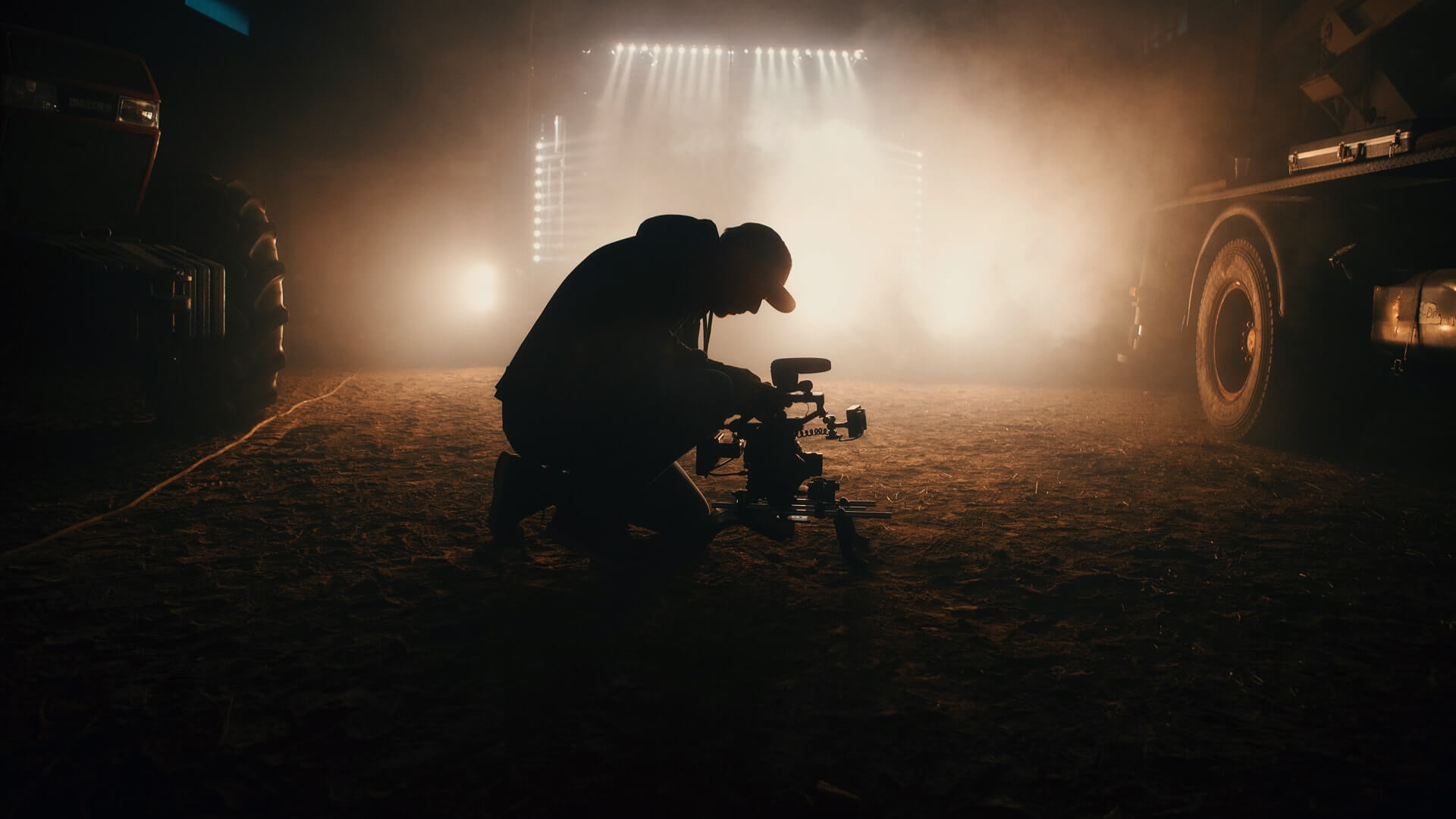Cinematography techniques are the visual methods filmmakers use to shape how a story looks and feels on screen.
The cinema techniques control framing, lighting, movement, composition, and lens choice.
This deep guide covers 30 cinematography techniques used by professional filmmakers and video creators, with practical explanations and examples that you can apply on set.
- Camera shots and framing (wide shots, close-ups, shot sizes)
- Camera movement techniques (pan, tilt, dolly, tracking shots)
- Lighting techniques (high-key, low-key, motivated lighting)
- Composition techniques (rule of thirds, leading lines, symmetry)
- Lens and depth techniques (focal length, depth of field)
- Visual storytelling techniques (blocking, camera motivation)
FREE Download: 30 Cinematography Techniques & Tips
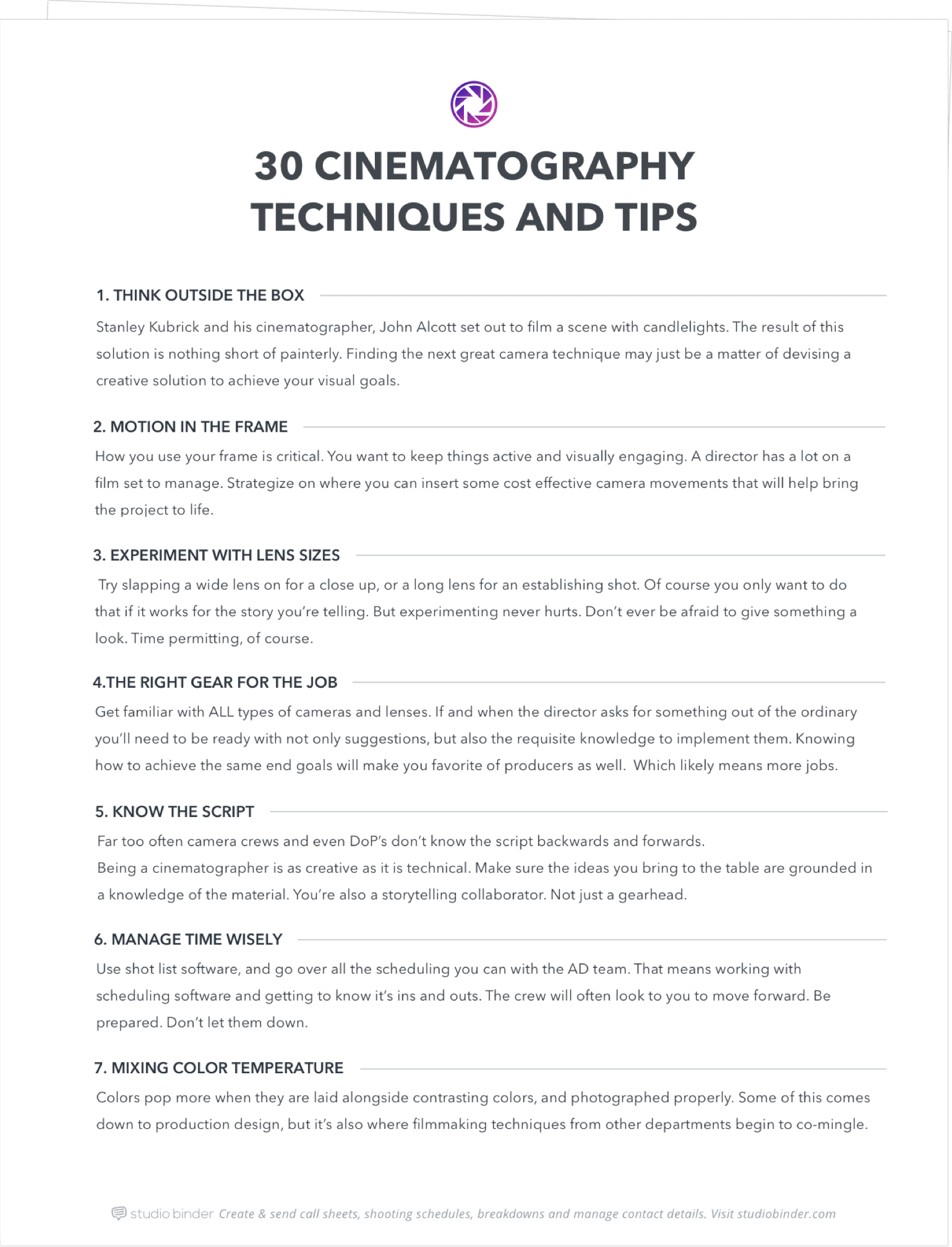
Download a FREE, printable camera techniques and tips (PDF) below.
On paper, you’re ready. You took the courses. You read the books. But do you know all the key cinematography techniques? The things that come from being on set?
Perhaps you’ve been working DoP for years. Would a quick refresher on some of the 30 best cinematic techniques and tips hurt?
We’ve compiled some of the best tricks of the filmmaking trade into this one post that will get you jobs, keep you working, and keep your work inspired.
So whether it’s on paper or on set, we’re gonna make sure you’re ready to shoot.
Let's jump in!
Cinematography Techniques at a Glance
- Camera shots: Control how much of the subject and environment is shown on screen.
- Camera movement: Adds energy, tension, or calm through pans, tilts, dollies, and tracking shots.
- Lighting techniques: Shape mood, realism, and emotional tone using light and shadow.
- Composition: Guides viewer attention through framing, balance, and visual structure.
- Lens choices: Affect perspective, depth of field, and spatial relationships.
- Blocking and staging: Use actor movement and positioning to tell the story visually.
What is cinematography?
“The art and the science of recording light.” We should always keep that in mind.
Cinematography is the art and the science of recording light either electronically onto an image sensor or chemically onto film stock for a motion-picture.
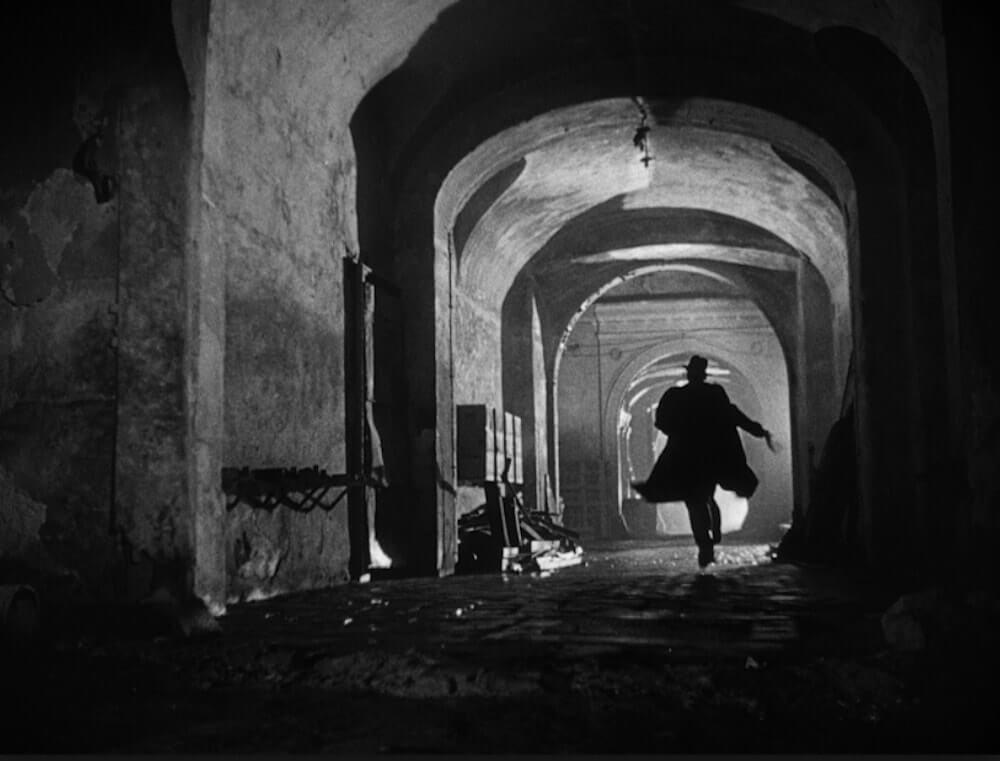
Masterful lighting and cinematic techniques gave The Third Man some of the best cinematography ever
That’s the job of the cinematographer in a nutshell. As we move forward through these 30 best cinematography techniques and tips, let’s keep in mind what the real aim of the job always is.
Key Takeaways
- Cinematography techniques are the visual methods filmmakers use to tell a story through framing, lighting, movement, and planning.
- Strong cinematography balances creative choices with practical workflow, time management, and collaboration on set.
- Many essential cinematography techniques have little to do with gear and everything to do with preparation and decision-making.
- Mastering these techniques helps filmmakers create consistent, expressive visuals across different budgets and production scales.
1. Think Outside the Box
Thinking outside the box is a cinematography technique where filmmakers push beyond standard tools and conventions to achieve a specific visual goal.
It often involves experimenting with unconventional equipment, lighting methods, or camera setups to capture images that would otherwise be impossible.
The best cinematographers think outside the box.
When Stanley Kubrick set out to film Barry Lyndon, he and his longtime cinematographer John Alcott wanted to break new ground and needed to develop some new film making techniques.
They wanted to shoot it all with natural light. A pretty daring and ambitious cinematography idea.
For an indoor candle-lit scene, they wanted to ACTUALLY film by candlelight. This would have pushed the film stock of the era too far.
So Kubrick and Alcott borrowed a special lens made by NASA to complete their scene.
The result of this solution is nothing short of painterly.
Finding the next great camera technique may just be a matter of devising a creative solution to achieve your visual goals.
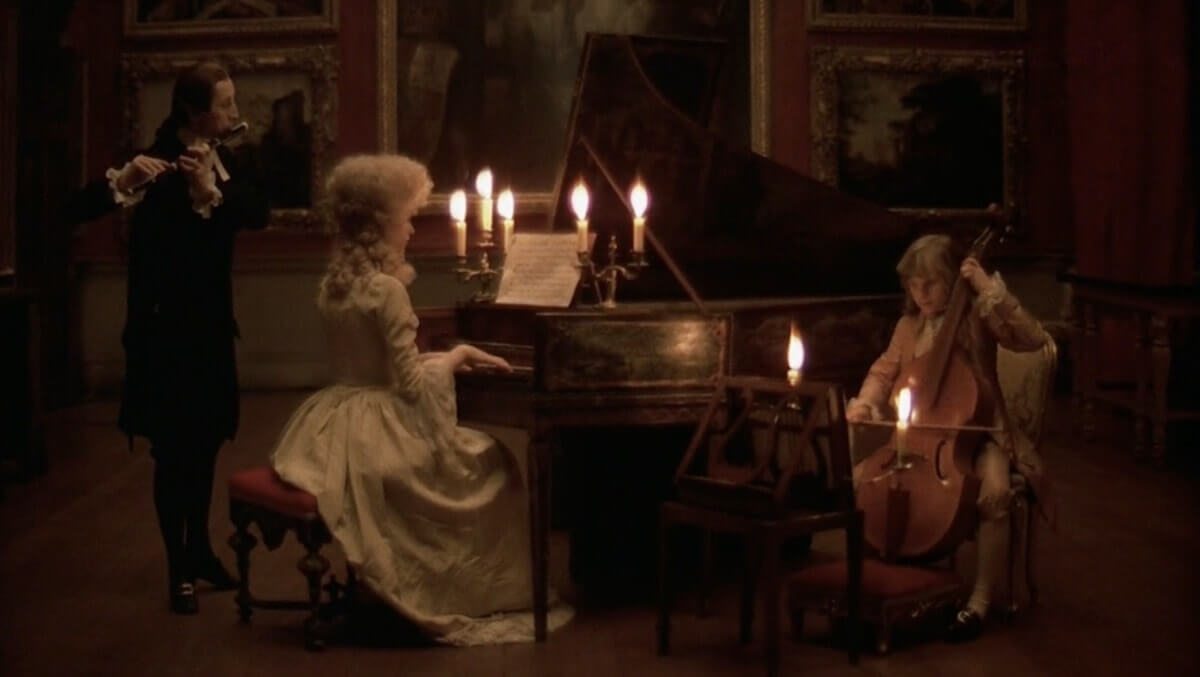
Unique cinematography techniques were used to create this stunning film image
The result of this solution is nothing short of painterly.
Finding the next great camera technique may just be a matter of devising a creative solution to achieve your visual goals.
2. Keep the Frame Moving
Keeping the frame moving is a cinematography technique that adds energy, momentum, and visual interest by moving the camera or the elements within the frame.
It is commonly used to maintain audience engagement, guide attention, and enhance the emotional rhythm of a scene.
How you use your frame is one of the most critical camera techniques. Whether it be moving that frame, or moving items within that frame. You want to keep things active and visually engaging.
A director has a lot on a film set to manage. Try identifying a way to get the camera moving during a rehearsal or blocking of a scene.
If production can afford it, talk with the director about where you could use a dolly, or a jib, or even a steadicam.
Strategize on where you can insert some cost effective camera movements that will help bring the project to life.
3. Get Creative with Lens Sizes
Getting creative with lens sizes is a cinematography technique that uses unconventional focal lengths to change perspective, scale, and emotional impact.
By pairing wide lenses with close-ups or long lenses with wide shots, filmmakers can create visually striking and unexpected imagery.
You don’t ALWAYS need a 21mm wide shot or an 85mm close up. Slapping a wide lens on for a close up, or a long lens for an establishing shot are creative film making techniques.
Of course you only want to do that if it works for the story you’re telling. But experimenting never hurt.
Sometimes the thing you ‘tried for fun’ gave you and the director a great inspiration and sent you in a great new direction.
Don’t ever be afraid to give something a look. Time permitting, of course.
4. Use the Right Gear for the Job
Using the right gear for the job is a cinematography technique that involves choosing cameras, lenses, and support equipment based on the specific needs of a project.
Rather than defaulting to high-end cinema packages, this technique focuses on selecting tools that best serve the story, shooting conditions, and production constraints.
Not every shoot will need a fully decked out Alexa package with cinema zooms. Sometimes a shoulder mounted ENG camera is exactly what a project needs.
Get familiar with ALL types of cameras and lenses. Not just the big ticket cinema stuff. Being precise about what you need is one of the most important cinematography techniques you'll develop.
Because if and when the director asks for something out of the ordinary you’ll need to be ready with not only suggestions, but also the requisite knowledge to implement them.
Knowing how to achieve the same end goals will make you favorite of producers as well.
Which likely means more jobs.
5. Know the Script
Knowing the script is a cinematography technique that ensures visual choices support the story, characters, and emotional beats of a film.
By understanding the script in detail, cinematographers can make informed decisions about framing, movement, and lighting that enhance storytelling.
Seems like another ‘no brainer’. At the same time, you might not have expected to see the script listed among cinematography techniques.
Yet far too often camera crews and even DoP’s don’t know the script backwards and forwards.
Being a cinematographer is as creative as it is technical.
Make sure the ideas you bring to the table are grounded in a knowledge of the material. You’re also a storytelling collaborator.
Not just a gearhead.
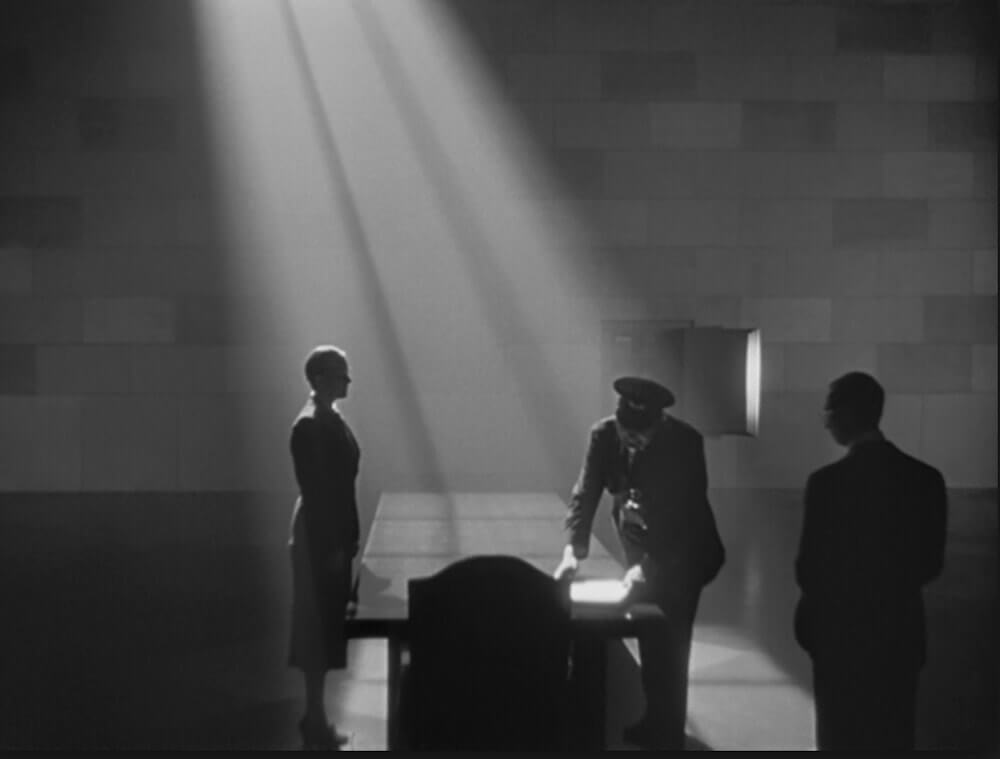
DoP Gregg Toland innovated and truly “changed the game” with light and shadow on Citizen Kane
A great early example of a DoP and Director innovating together and serving the story is Citizen Kane.
DoP Gregg Toland kept his depth of field, and used light and shadow to direct the eye, creating a more dramatic look.
Without a focus on how to serve the story, such innovation would have been rendered meaningless.
So?
Make notes in your script. Bring up visual suggestions, questions, and ideas.
Have conversations about styles to emulate, other film’s this story reminds you of. The better you know the project the better you’ll be able to help serve it.
6. Manage Your Time Wisely
Managing your time wisely is a cinematography technique that ensures the camera and lighting departments work efficiently under tight production schedules.
It focuses on planning coverage, setups, and lighting in advance so visual quality is maintained without slowing down the shoot.
The camera and lighting crew is often the biggest crew on a film set.
You are going to be interacting with all of those department heads, and you are directly (or indirectly) in charge of all of them and their work.
THis means always having a plan and executing it.
This means having and respecting storyboards and a shot list. Using those tools are cinematography techniques unto themselves.
Why?
You will ALWAYS be under the gun for time. Just like money, there is never enough.
The 1st AD will be asking how low until picture is up constantly.
Because the Producers will be asking HIM how long until picture is up constantly.
So before you even STEP on set know the coverage. Know the set-ups. KNow the lighting plans. Know it all backwards and forwards and how you’ll move efficiently between them.
In film school you probably learned how to light. Maybe even how to light really well.
But did you learn how to light fast? Or how to adjust when daylight is almost gone? When you might not make the day? And the entire production is waiting on your team getting a little fill on the lead actress?
Be ready.
But how?
Use shot list software, and go over all the scheduling you can with the AD team. That means working with scheduling software and getting to know it’s ins and outs.
The crew will often look to you to move forward. Be prepared.
Don’t let them down.
7. Mix Color Temperatures
Mixing color temperatures is a cinematography technique that creates visual contrast and emotional tension by combining warm and cool light sources within the same frame.
It is commonly used to add depth, separation, and mood in color cinematography.
We’ve mentioned some classic black and white inspirations and cinematic techniques, but what about the standard today (for the last 60 years) which is color?
Try using colors to create the same kind of dramatic contrasts and juxtapositions.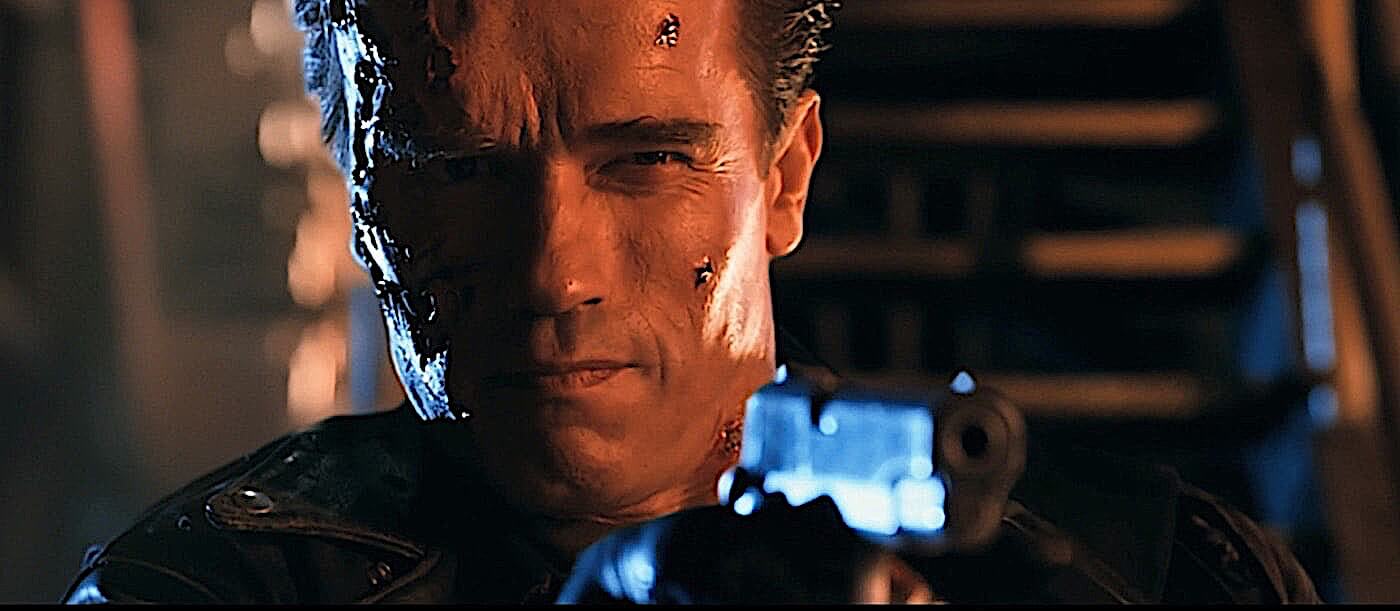
Mixing discordant colors can be a dramatic and effective cinematic technique
Suddenly the image catches the eye in a different manner than before. Similar to the way the older cinematic technique using bright outlines and shadow did for black and white cinematography.
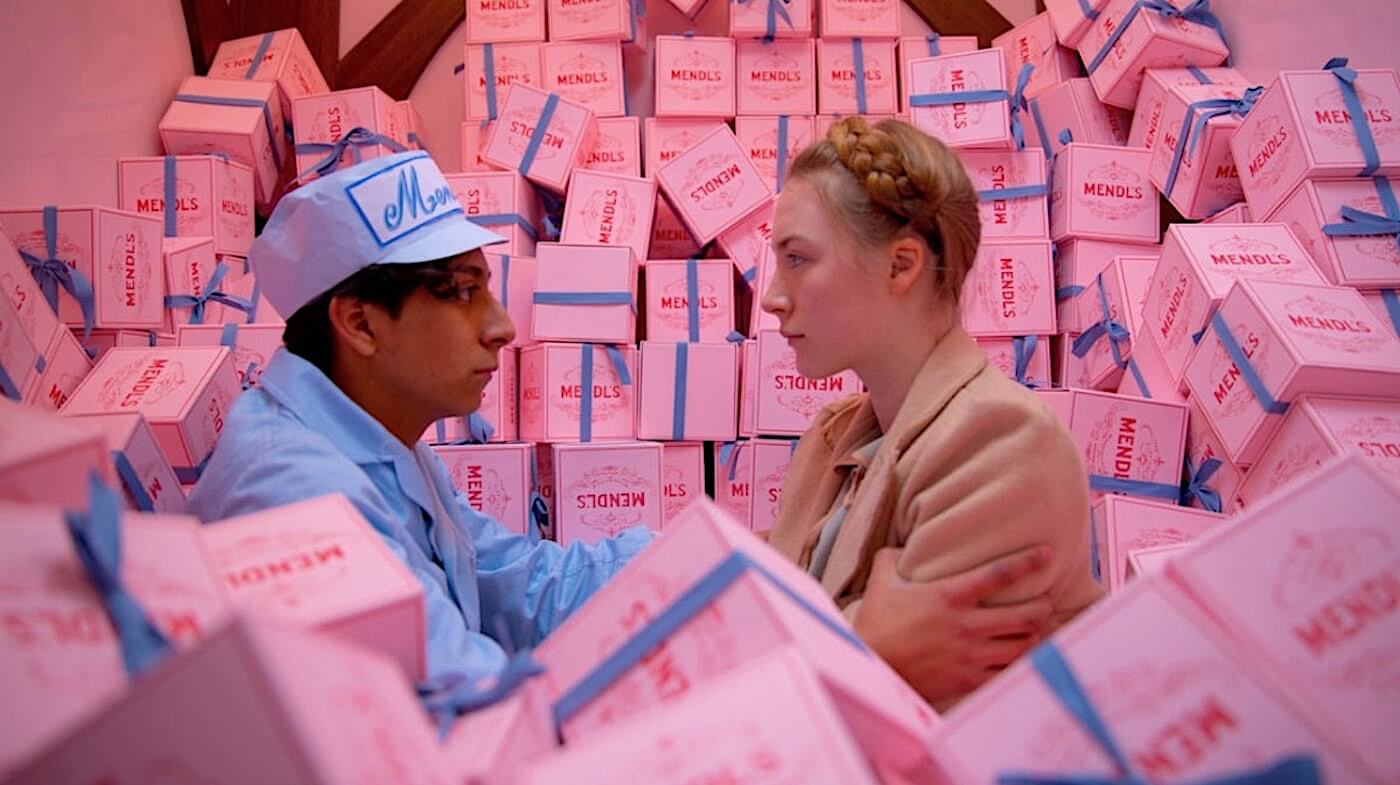
Wes Anderson loves color. One of his preferred filmmaking techniques is to play with the center space of the frame.
Colors pop more when they are laid alongside contrasting colors, and photographed properly.
Some of this comes down to production design, but it’s also where filmmaking techniques from different departments being to co-mingle.
To learn more about color theory, check out our FREE Ebook.
8. Tell a Good Story
Telling a good story is a cinematography technique that prioritizes narrative clarity and emotional connection over flashy visuals.
It ensures that camera movement, lighting, and composition serve the characters and story rather than distracting from them.
“There’s nothing worse than an ostentatious shot or some lighting that draws attention to itself, and you might go, ‘Oh, wow, that’s spectacular.’ Or that spectacular shot, a big crane move, or something. But it’s not necessarily right for the film — you jump out, you think about the surface, and you don’t stay in there with the characters and the story. ”
– Roger Deakins
Who are we to argue with Roger Deakins, one of the greatest cinematographers of all time?
Remember you are always telling a story. A visual story, yes, but a story all the same.
Some of the best cinematography ever became practically invisible in its service of the story. Gordon Willis, the genius director of photography behind moody oscar winning classics like The Godfather and Manhattan, took an entirely different approach to All The President’s Men.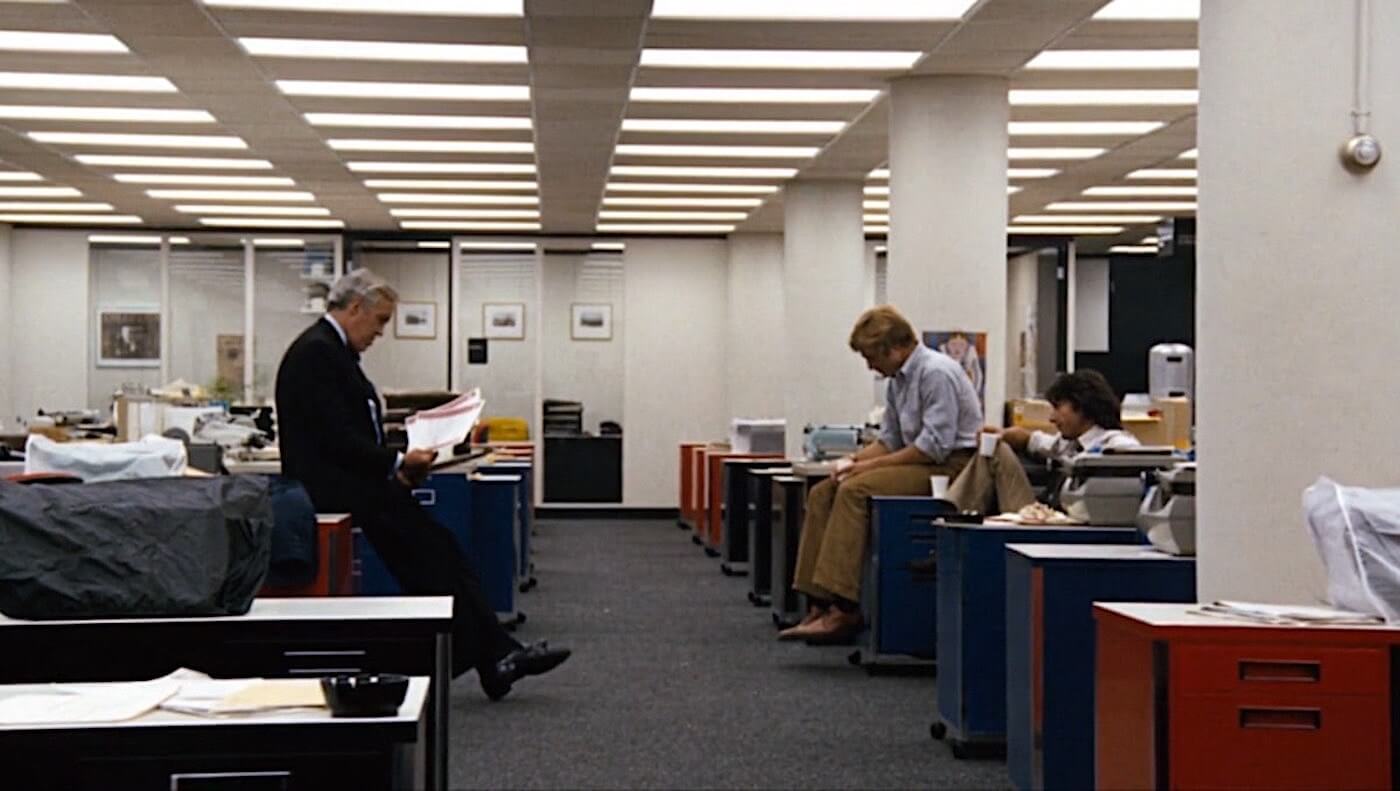
Cinematographer Gordon Willis used light to show that in the Post newsroom, light would uncover the truth.
Perhaps the greatest cinematography technique you have will be your ability to recognize what will serve the story.
9. Consider Your Favorite Cinematography.
Studying your favorite cinematography is a cinematography technique that helps filmmakers develop visual taste, intuition, and creative direction.
By analyzing influential films and cinematographers, you can draw inspiration and apply proven visual ideas to your own work.
Remember to stay inspired. What do you think is the best cinematography ever? Who is the best cinematographer?
Of course it’s partly a matter of taste. Some of the greatest cinematic creations came party through that very source of inspiration.
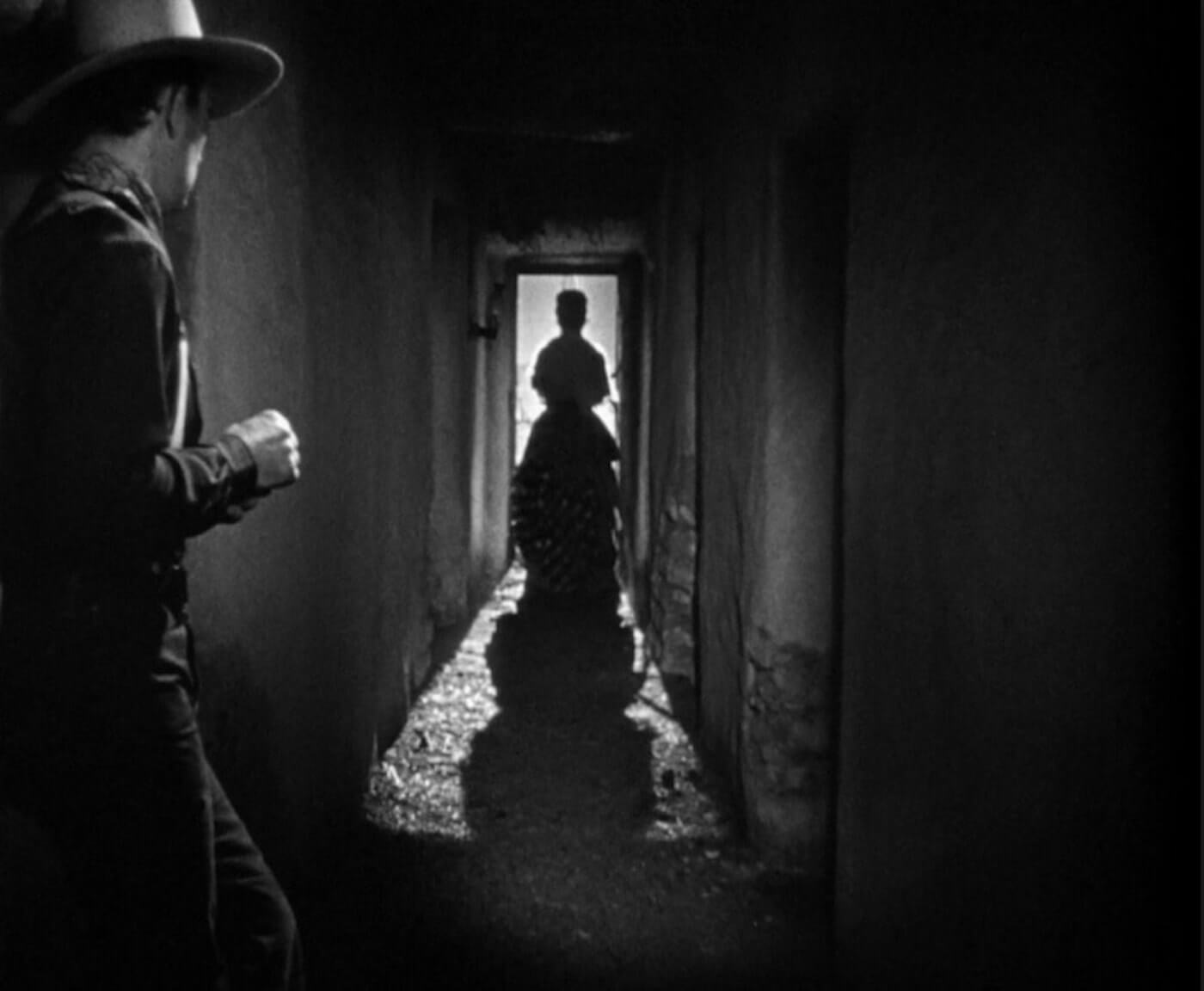
John Ford’s cinematic technique in Stagecoach had a big influence on a then young Orson Welles
When asked how he made Citizen Kane Orson Welles said “John Ford, John Ford, and John Ford”.
This was in reference to Ford’s own classic Stagecoach, which pioneered not just the western(no pun intended), but some of the dramatic chiaroscuro film lighting and camera technique.
It’s safe to say Orson Welles considered Ford’s work to have some of the best cinematography technqiues ever. His inspiration for his own cinematography ideas was so powerful, it led him right into his own all time classic.
And new innovations.
10. Be an Artist
Being an artist is a cinematography technique that applies principles of visual art and design to each frame.
It helps cinematographers create images that are visually balanced, expressive, and intentional while still serving the story.
While you shouldn’t get to precious with your work, and alway serve the story, be versed in visual art and design terminology.
It can be great shorthand with your Director and Production Designer, as well as others.
Time is of the essence and great cinematography need not be painstaking. At the same time, treat your shots, and each frame, like a work of art you want to get right.
Even if you’re doing it on the fly, make sure your framing works from a purely visual standpoint. There are many excellent camera techniques you can implement to achieve this.
Take some time to familiarize yourself with great artwork. The tools of creating powerful images may have changed, but the basic principles have remained the same for hundreds of years.
11. Look Through the Frame
Looking through the frame is a cinematography technique that trains cinematographers to visualize composition before the camera rolls.
It ensures that framing, balance, and visual focus are considered from the audience’s point of view.
Even if you aren’t looking through a monitor, it’s vital that you look at your shoot through a frame of some kind. Whether it’s an old-school director’s viewfinder, a still camera, or just your fingers.
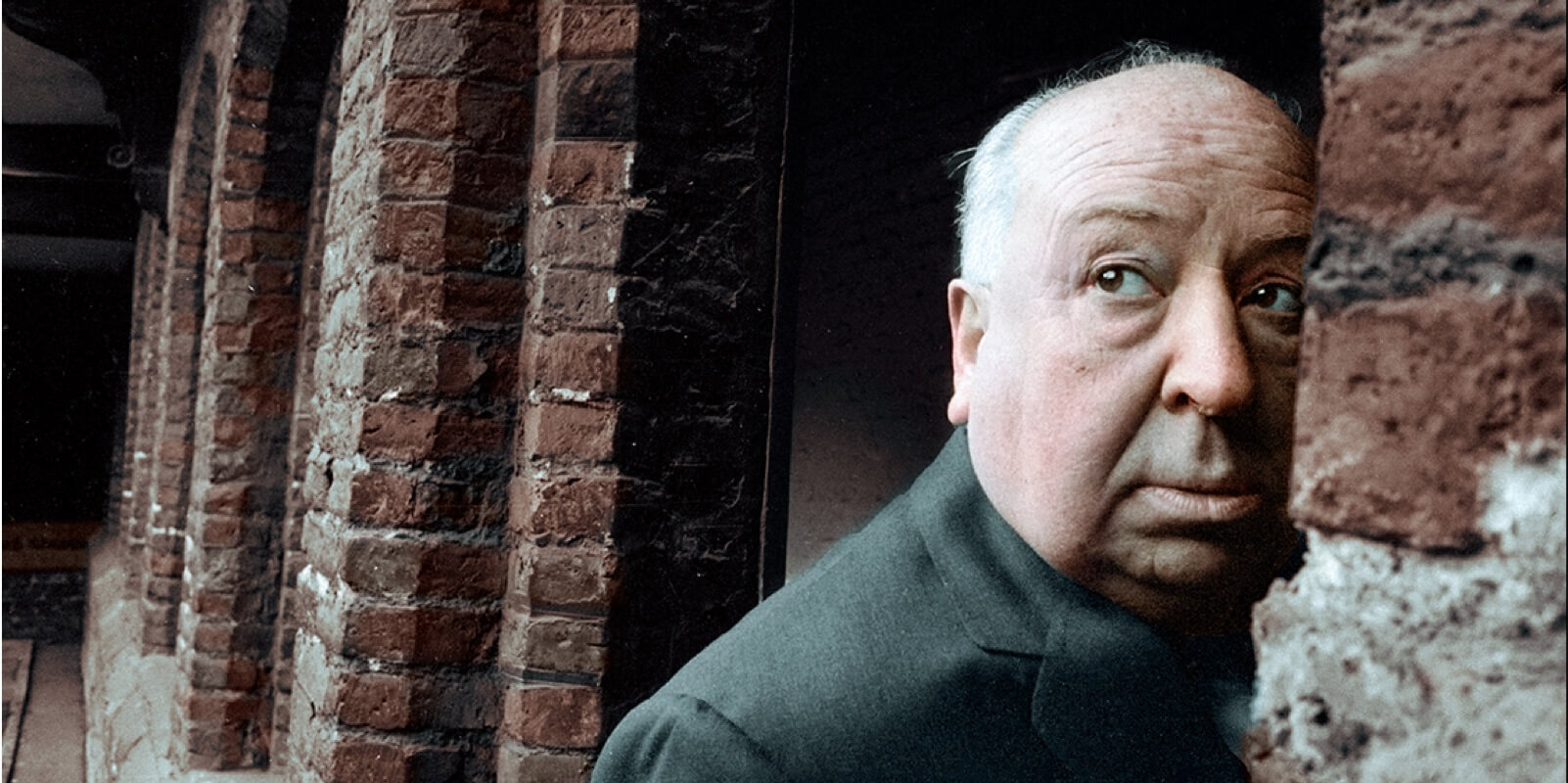
Even the great Alfred Hitchcock resorted to the finger-frame.
This frame is what the audience will ultimately see, and you have to be able to picture what’s going into it. Any device that helps train your eye to think of the world in terms of the frame will make you a better cinematographer in the long run.
12. Experiment with Hard Light and Soft Light
Experimenting with hard and soft light is a cinematography technique that shapes mood, contrast, and visual texture.
By choosing between hard and soft lighting, cinematographers control shadow detail, light spill, and emotional tone.
Hard and soft lighting create very different feelings. Try experimenting with both to get a sense of what you like for what types of scenes.
A lot of people are using LED panels nowadays but it nearly eliminates all hard light (which may not be the preference). Use fresnel and pars when appropriate.

Hard lighting would definitely qualify as a sexy cinematic technique
Hard light is way easier to control than soft light. Hard lights can be softened, but soft lights can’t be hardened. If you really need to control shadows and keep light from spilling everywhere a fresnel will make your life easier than a kino.
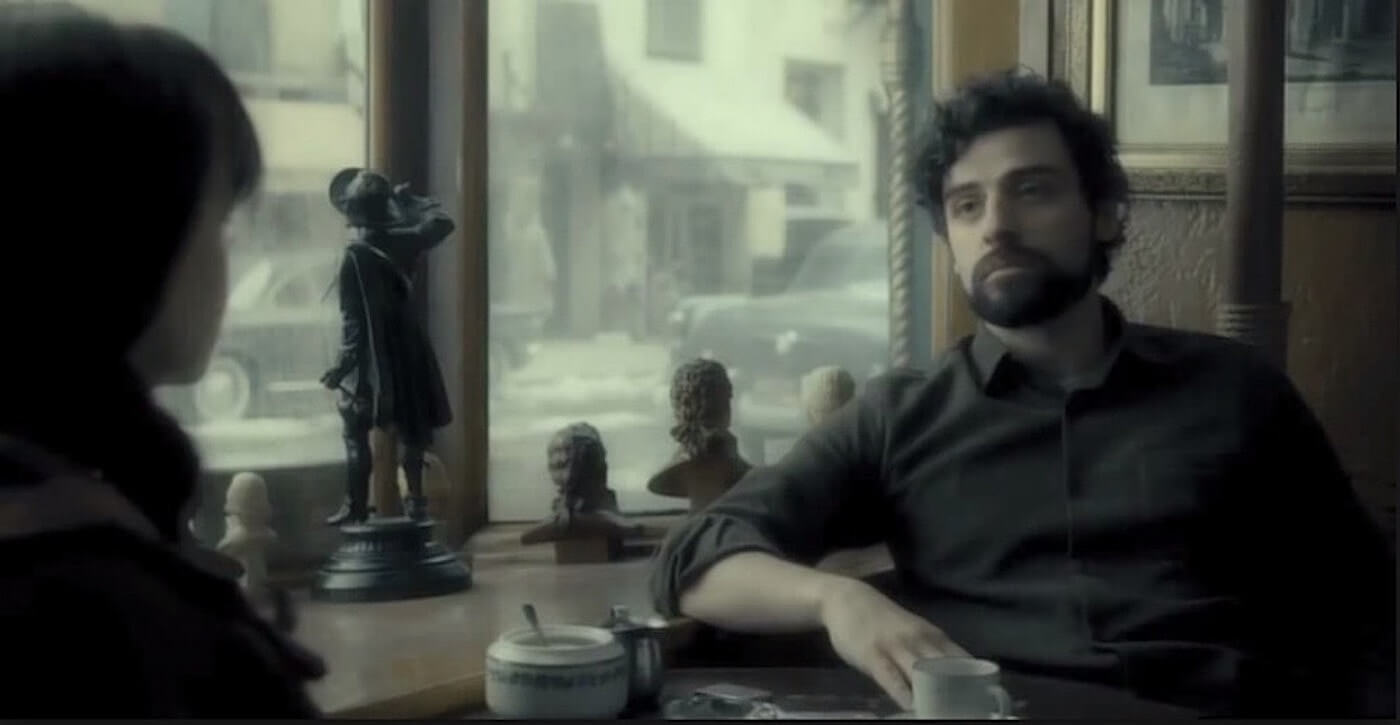
Much softer lighting used here by the Coen Bros isn’t as ‘sexy’ but helps convey the internal state of the character.
You don’t need to always opt for what looks sexiest, of course. Remember one of our other cinematography techniques: telling a good story.
13. Bring a Quality Still Camera to Tech Scouts
Bringing a quality still camera to tech scouts is a cinematography technique that helps plan framing, lenses, and camera placement before the shoot.
It allows cinematographers to test focal lengths and compositions in real locations with greater accuracy.
Bringing a camera on location scouts is so important, we hesitate to even refer to it as one of our cinematography techniques. But it does merit some further consideration.
When all else fails, you can use your phone, but ideally you want a DSLR with the same size sensor as your shooting camera.
Most 35mm equivalent cinema cameras have an APS-C (or close to) sensor.
You should also bring a zoom that has the same approximate focal range as the lenses you’ll be shooting on. You can test out different focal lengths and find exact camera positions.
14. Make a Shot List
Making a shot list is a cinematography technique that organizes coverage, camera setups, and visual priorities for a scene.
It ensures efficient shooting while maintaining clarity, consistency, and storytelling intent.
You’ll want to make a shot list right after a tech scout to determine what lenses you need. A well organized shot list is going to be one of your best tools on set.
In StudioBinder, you can create a new shot list. From there you can spin off new shots, group and sort your shots by type.
You can even add pictures from your scout directly into the app, which will create a storyboard you can show your director.
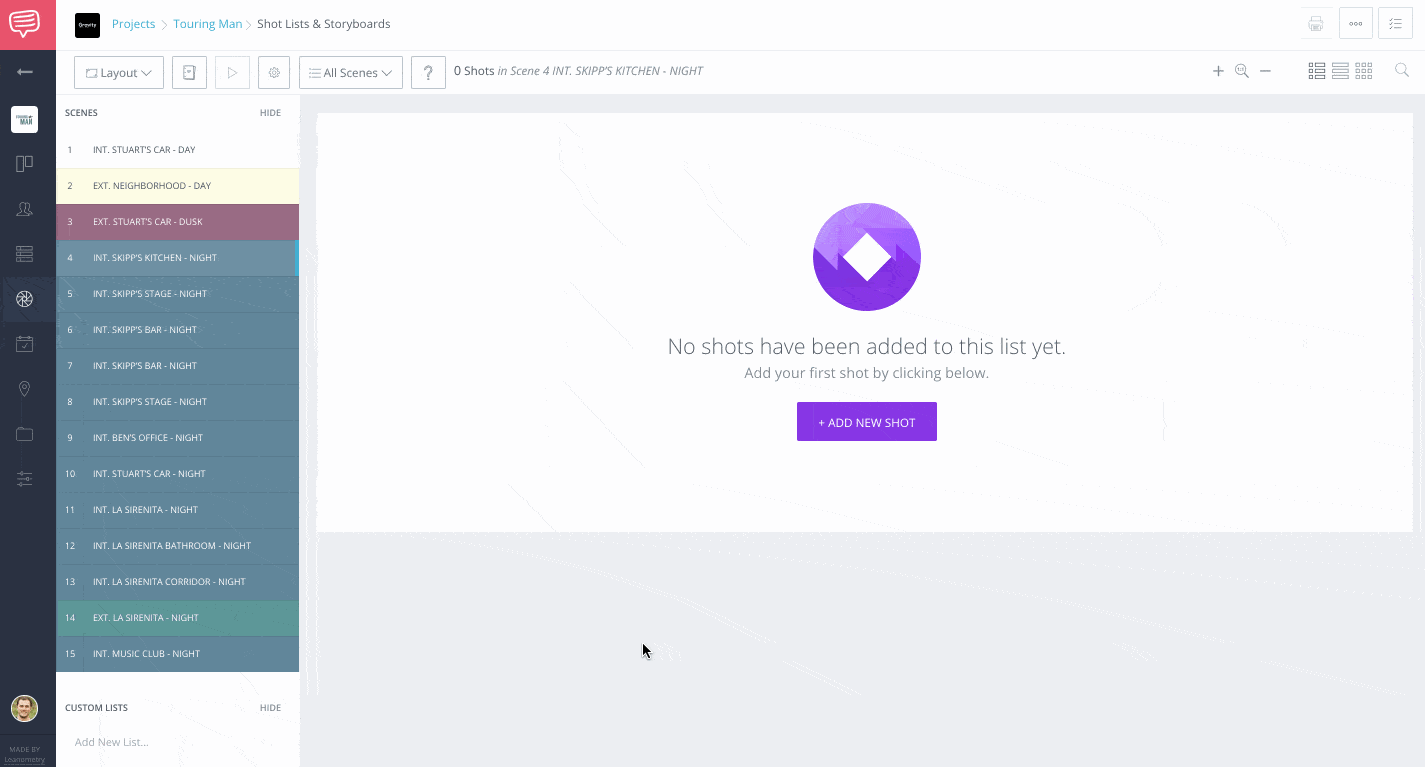
You can also quickly add and organize shots on the go.
Many other cinematography techniques are dependent on your ability to understand and utilize tools like this first!
15. Find Great Locations
Finding great locations is a cinematography technique that enhances visual storytelling through environment, scale, and atmosphere.
The right location can add production value, realism, and emotional impact that cannot be replicated on a stage.
We mentioned John Ford before, but another thing he helped institute was shooting on location for maximum visual impact.
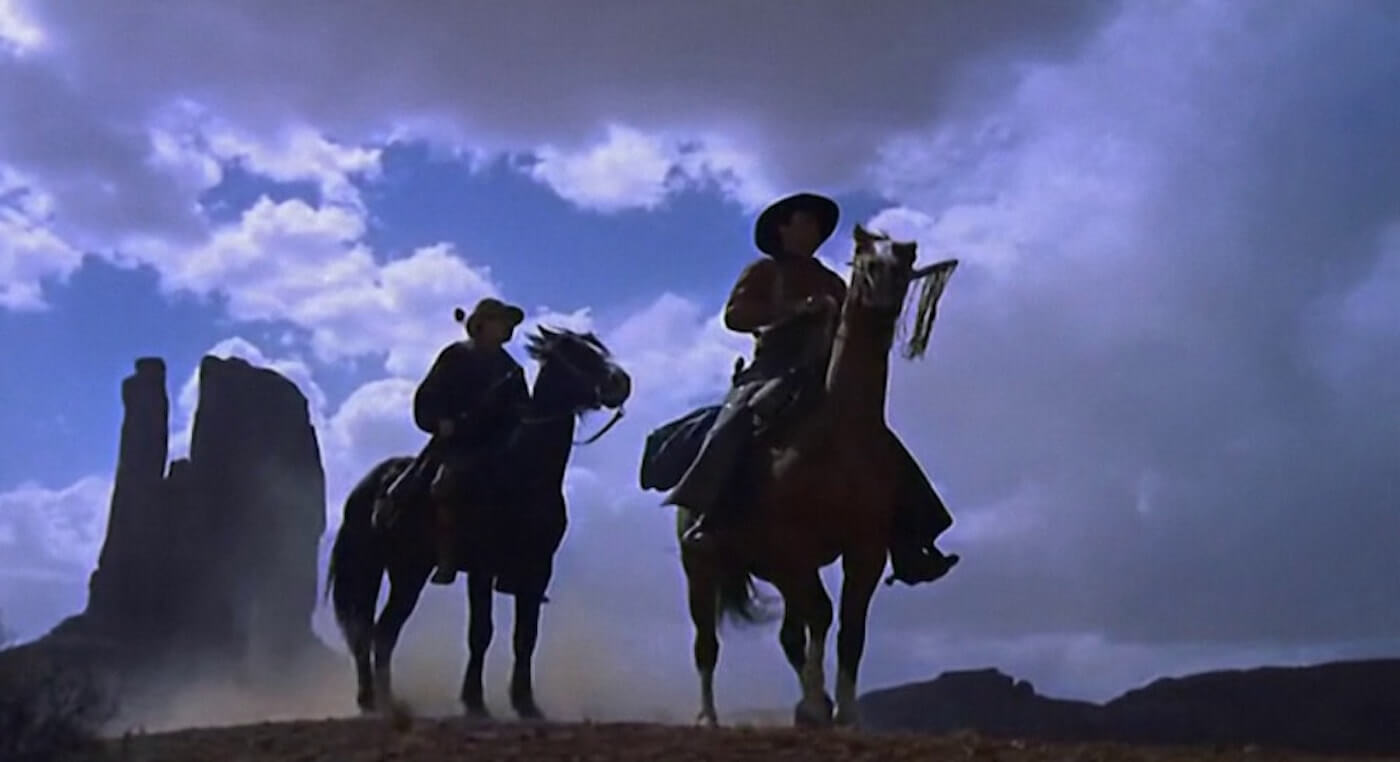
Ford kept going back to monument valley because simply turning on a camera there is a nice cinematic technique
Ford shot countless westerns in Arizona’s stunning natural landscape of monument valley.
He knew the location well, and the towering red rocks helped him frame his shots perfectly.
Find good locations. Understand what the light will look like there at different times of the year, or day (more on that later).
The better your locations, the better your look with potentially less work from you and your crew.
16. Find Ways to Add Depth
Finding ways to add depth is a cinematography technique that creates the illusion of three-dimensional space within a flat image.
It helps guide the viewer’s eye and strengthens visual storytelling through layering, movement, and composition.
You probably already know that all depth in film is, essentially, an illusion. You’re tricking the eye into believing that a flat picture has a third dimension it really doesn’t have.
So how do you really use that in terms of story?
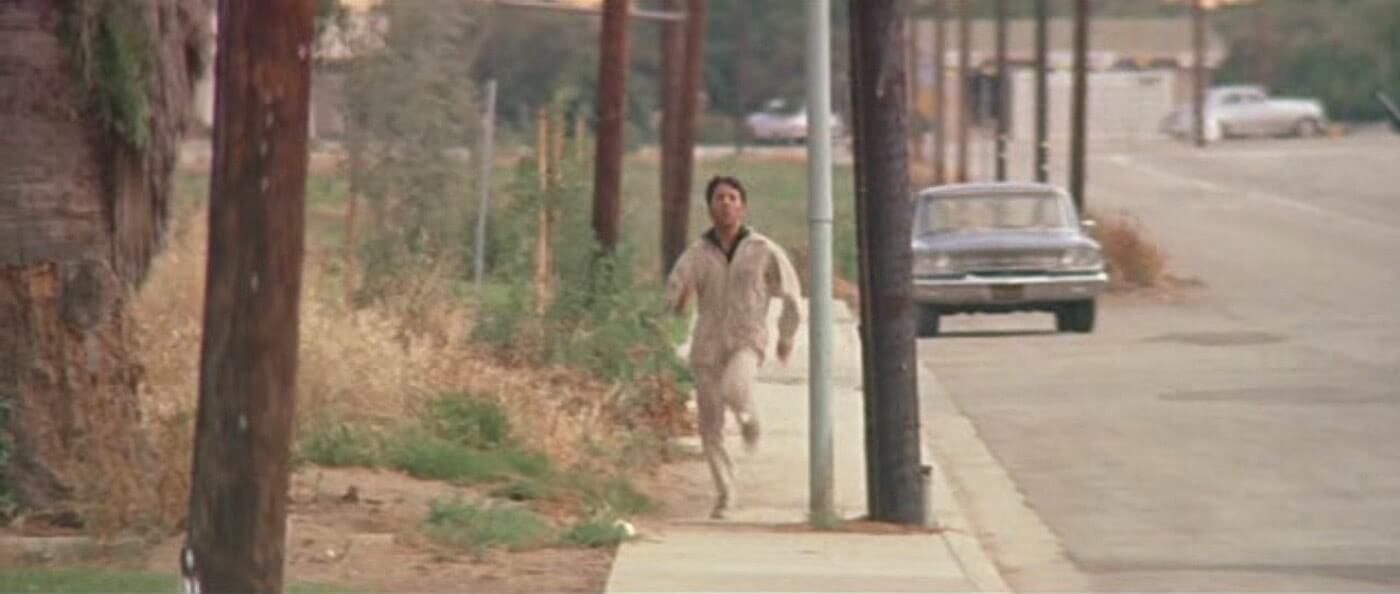
In The Graduate, Ben runs towards a telephoto lens. It gives the impression he’s getting nowhere.
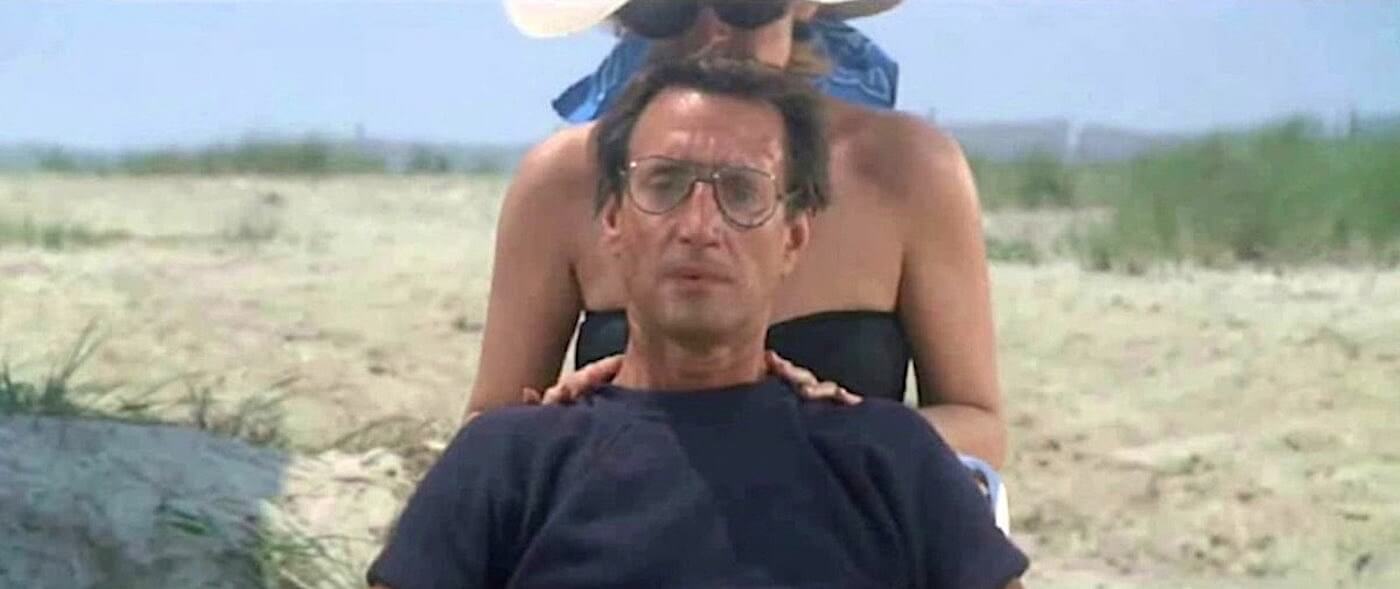
In Jaws, the depth of field is toyed with to emphasize the impact of the moment of terror. This is called a "dolly zoom."
There are many ways you can add depth, and moving beyond one trick is essential if you want to move to the next level of cinematography techniques.
Check out this article by NoFilmSchool for 5 ways you can add depth to your shots.
17. Never Say "Fix It in Post"
Avoiding the “fix it in post” mindset is a cinematography technique that prioritizes capturing the desired look on set.
It emphasizes planning, lighting, and execution during production rather than relying on costly post-production fixes.
Well, you can say it. Sometimes it’s fun to say.
Just try not to depend on it.
The best cinematography typically comes from your locations and lighting and not with DaVinci Resolve. Post production software will not be listed among our cinematography techniques.
Plus, whatever you can’t capture naturally on-set, might takes way more time and money to recreate in post.
The best way to make sure to get the best look the first time around? Give yourself TIME to create it.
That’ll mean planning the shoot carefully, and committing to your game plan on set. Creating an efficient shot list will help make sure you have time to explore and find the perfect look.
If you don’t think you’ll have time, then use the pre-vis stage to create a fleshed out story board with images that you can almost consider a “test run”.
If it looks good here, chances are it’ll work for you on set.
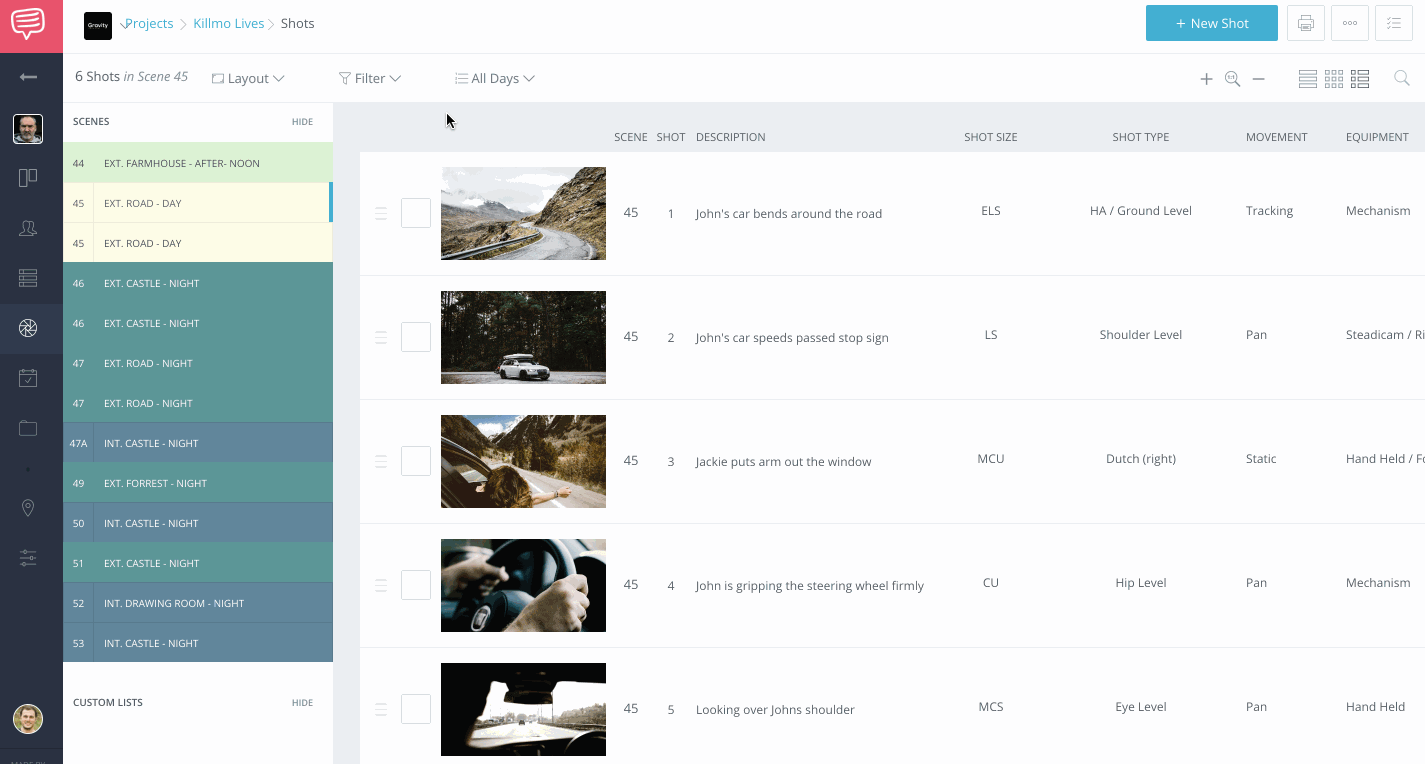
A finished shot list in StudioBinder
Remember, you are being hired for your expertise in cinematography techniques.
Your producer will love you for saving him thousands. Post fixes are way more expensive than having the Art Department touch up a flaw.
18. Hire the Right Team
Hiring the right team is a cinematography technique that leverages the experience and creativity of skilled collaborators.
It allows cinematographers to solve problems more effectively by trusting and empowering department heads.
Remember how we mentioned that huge crew?
And how you’re in charge of them?
Well, keep in mind that starting out you may not be the most experienced person on set.
In fact the most experienced person may be working for you, with years of filmmaking techniques and experience under their belts.
Your gaffer and key grip in particular are both highly trained creative individuals.
Use them to help solve problems. You don’t have to figure everything out on your own.
Check your ego at the door.
This is a pretty good policy no matter what you are doing. Ego’s only ever get in the way.
19. Lead Your Crew
Leading your crew is a cinematography technique that combines clear communication, decisiveness, and respect on set.
Strong leadership improves efficiency, morale, and the overall quality of the finished film.
Some of the most important filmmaking tips aren’t actually cinematic techniques, but people skills.
Crews respect clear, fast decision making.
Be aware of how much work you’re creating for them.
They’re probably happy to do the work but will become unhappy if they find themselves being told to take down a light and then they have to put it right back 15 minutes later.
So be clear and respectful. Take the blame for mistakes. Be a responsible leader.
Efficient cinematographers are the best cinematographers in the crew’s eyes. Because it means good cinematography, fast setups, and finishing on time.
Keep track of who you’ve worked with in your crew, and who you’ve worked for in production in a crew database like StudioBinder.

Learn more about how to use Studiobinder’s crew contact lists here.
You don’t want to lose track of anyone, or forget them.
You never know who you might need on a job, or who the next job might come from.
Utilizing and managing your team are both good cinematography techniques.
20. Prepare to Do It All
Preparing to do it all is a cinematography technique that requires understanding every role involved in production.
This broad knowledge helps cinematographers adapt quickly and keep the set running smoothly under changing conditions.
You probably left film school with certain ideas about what a cinematographer's role on set was.
Surprise!
It won’t always be that way.
On some jobs you’ll have to serve as your own gaffer. And electric. And grip. And… production designer.
The list could go on.
You should have a working knowledge of every role on a set.
This isn’t just in case you have to fill in.
It’s also so you can understand and respect the process of everyone else’s work.
Knowing how long to give hair and make-up is important. Knowing that you need to allow for them to have “last looks” before you roll can also come in handy.
The set needs to flow, which means you need to be in sync with everyone else.
It’s ideal not to act as though you are an island.
So get to know the whole process.
And be ready to fill in…
21. Your Reel > Your Camera Gear
Prioritizing your reel over camera gear is a cinematography technique that focuses on skill and creative problem-solving rather than equipment.
It reinforces that strong visual storytelling matters more than owning the latest technology.
Things break, gear gets obsolete, and spending 100K on fancy camera gear will not make jobs come to you.
You’re a cinematographer, not a rental house.
The best cinematographers can create the best cinematography from any camera they’re handed.
The job is to know how to evaluate the limitations and advantages of your gear, reach into your bag of film techniques, and make the best image under those conditions.
Equipment will come and go. Your expertise and skills on-set will only get better with time.
22. Don't Go Into Debt for Gear
Avoiding debt for gear is a cinematography technique rooted in sustainable career planning.
It encourages cinematographers to invest carefully and rely on expertise rather than expensive equipment.
This is a good guideline in general.
Going into debt is never ideal.
When it comes to camera gear there can be a tendency to try and make yourself and your work more appealing by owning all the cool toys.
It might help a little. But it’s not worth creating debt over it.
If you want to invest in one camera, say, and you think you can make the cost back in a job or two, sure.
Invest carefully. Know that your quality of work, and how it is to work with you, will factor in more than how much gear you own.
The dirty little secret?
Once Producers know you own some cool gear, they might hire you hoping to get it for free. Or at least heavily discounted.
Producers. Gotta love ‘em, right?
23. Understand Modern Drone Technology
Understanding modern drone technology is a cinematography technique that expands visual possibilities while respecting technical limits.
It helps filmmakers choose when aerial shots enhance a story and when they do not.
Technology marches on, as it is wont to do.
Aerial drones with cameras attached have gotten cheaper and cheaper, and fly-over shots that were once the providence of well-heeled studio productions are now yours.
But as amazing as drones are, they do have their limitations.
Like they can’t direct actors.
YET...
Understanding what a drone can and cannot do is important if you want to have a good relationship with your drone pilot.
For example, did you know that most drone cameras currently don’t have zoom lenses?
Learn more about drone cinematography techniques.
Also while this ‘technique’ is about Drones, it really applies to any and all technology that comes along.
There will be no shortage of new toys to play with.
Research them as best you can. Know how and when to use them.
24. Know When to End Your Reel
Knowing when to end your reel is a cinematography technique that respects audience attention and emphasizes quality over quantity.
A concise reel ensures your strongest work makes the biggest impact.
This is more of a job hunt technique than a film technique.
Nevertheless, remember that people have short attention spans.
VERY short attention spans.
So when designing a reel to send out to jobs or post on ProductionBeast, keep it short.
Many directors and producers will decide to turn it off in the first 30 seconds.
Don’t take it personally. They have tons of these to watch.
Use that knowledge as a tool to create a better reel. Grab them with your best stuff first.
And then get out fast.
So even if you’re one of the best cinematographers in the world, you’re looking at 2:30 max.
Also don’t pad your reel. Shorter and higher quality is better than a few more shots, some of which aren’t the best.
25. Don't Argue in Public
Avoiding public arguments is a cinematography technique that protects collaboration and on-set morale.
Handling disagreements privately helps maintain trust, authority, and a productive working environment.
Try not to argue.
Disagreements happen all the time. The first thing you should try and do is see where the other person might be right.
After you’ve done that and there is still a fundamental ‘misunderstanding’...
I’d ask for a sidebar. Take a moment to cool down, and discuss away from everyone else.
Then talk it out.
Because n one ever looks good calling people out in public. Even if you are right.
Also doing the whole “Can I talk to you alone for a second” might as well be arguing on set.
So find a tactful peaceful time and place to approach this talk.
This is especially true if it’s cinematographer vs. director.
Directors can get defensive if challenged in front of people, because they look like they’re not in charge. Taking privately eliminates that fear of embarrassment.
Remember what we said about egos? Check them at the door.
At the same time, recognize that not everyone else will be doing that. So be careful of egos.
They are FRAGILE.
A film crew on a set is like an army going into battle. Remember who the enemy is. It’s not the men and women you are in the trenches with.
Keep morale high, fight for the same things. Approach disagreements as though you want to same end result and just see different paths. Work together to find the right path.
This sort of approach will keep your set functioning well. It’ll keep you working.
It’ll keep you sane.
Before you get to set, have some go-to strategies for working with difficult crew.Of all the cinematography techniques, that one might serve you the most.
26. Develop (and Follow) a Workflow
Developing and following a workflow is a cinematography technique that brings consistency and predictability to the set.
A clear process improves communication, efficiency, and overall production rhythm.
As cinematographer Art Adams puts it: “Block. Light. Rehearse. Tweak. Shoot. Repeat. Every. Single. Setup.”
It really is that important. If you can’t light the actors, use stand-ins.
Make sure they’re at least same height and approximate skin tone. All the film techniques in the world can’t light someone who isn’t there.
A key part of this is communicating that this will be necessary to the director, 1st AD, and the actors. Everyone wants to work with you, but no one likes be surprised.
If you keep a consistent workflow then you become easier to predict. Your team knows what to start doing when.
Suddenly the production starts to hum along.
This is a good thing.
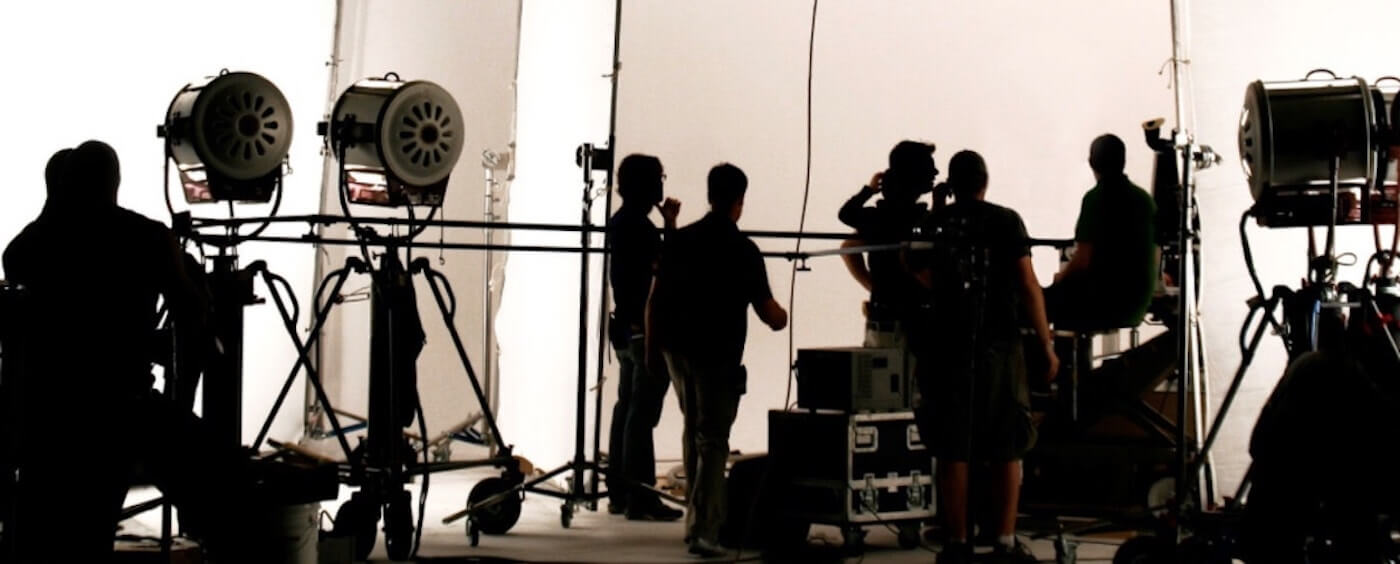
Look at this happy film crew just humming right along...
27. Check and Double Check the Call Sheet
Checking and double-checking the call sheet is a cinematography technique that ensures accurate planning and on-time execution.
It helps cinematographers anticipate schedules, locations, and logistics that directly affect lighting, setup, and workflow.
The triple check the call sheet.
Why?
Because otherwise you could be late. Or in the wrong place.
You might get through film school without ever seeing a proper professional call sheet.
Does this really belong among other cinematography techniques?
Maybe. Maybe not.
Do it either way.
If that’s the case, look at some now. Check out the call sheet function in Studiobinder and get to know what you’ll be looking at.
This is what production will send you EACH day. You’ll want to know where everything important is on it.
They will put in important details about the next days shoot. Many of them you will be consulted on.
Some of them are just good to know.
For example, how long will you have between crew call and first shot?
How long will you have to change scenes?
What time is the talent arriving? When are they done make-up? How does any of this effect your planning?
I don’t know.
But you should.
And you WILL.
Because you’re going to know all about call sheets before you even get one.
28. Perform Camera Tests
Performing camera tests is a cinematography technique that reveals how a camera responds to light, color, and exposure before the shoot.
Testing allows cinematographers to plan lighting and shooting strategies confidently instead of discovering limitations on set.
Learn how to do traditional camera tests with a chip chart, color chart, and human models, and then do them once you get your hands on the camera.
With proper testing, you can see exactly how the camera reacts before you get on set and determine a lot of lighting and shooting strategies beforehand.
As opposed to on set where you’ll have a dozen people waiting for you to get to know the camera.
You might have learned to do this in film school. But we’re putting it here because we don’t want anyone to take it for granted.
Sometimes certain basics fall by the wayside. This is one you should never let that happen to.
For the best cinematography, be sure to test:
- Different camera settings (ISO, working stop, LUTs, color spaces, etc)
- Filters
- Lighting choices (color temps, diffusion, direction, brightness)
29. Choose a Working Stop
Choosing a working stop is a cinematography technique that maintains visual consistency and optimal lens performance.
By sticking to a consistent aperture, cinematographers control depth of field, sharpness, and exposure across scenes.
Changing stops shot to shot leads to depth of field inconsistencies, since lens sharpness changes at different stops.
Most lenses are sharpest at 2-2 ½ stops closed from wide open.
For every scene you should be able to choose a single exposure and stick to it for every angle.
In some cases stick to a single stop for a whole sequence or the whole show.
Know the trade offs when you pick your stop.
Shooting wide open almost always means less sharpness when the lens is in focus.
30. Take Creative Chances
Taking creative chances is a cinematography technique that pushes visual storytelling beyond safe or conventional choices.
When calculated and intentional, creative risks can lead to more distinctive and memorable cinematography.
Push yourself creatively.
We covered this a bit in other cinematography techniques, but emphasis never hurt.
The overall idea here is to emphasize that taking risks can pay off.
If they are calculated ones that you run by others.
Don’t be afraid to break some of those rules you’re instructors drilled into your heads. Rules were made to be broken.
Plus...
Playing it safe leads to getting into the habit of average/mundane shooting.
Your best cinematography might appear when you think out of the box.
Pick your spots, of course. If you get too crazy all the time you might have some issues staying employed.
FAQ: Cinematography Techniques
1. What are cinematography techniques?
Cinematography techniques are the visual methods filmmakers use to tell a story on screen. They include camera shots, lighting, composition, camera movement, lens choices, and workflow practices that shape how a film looks and feels.
2. What are the most important cinematography techniques to learn?
Some of the most important cinematography techniques include understanding camera shots and framing, controlling light and shadow, managing camera movement, composing images effectively, and planning shots efficiently with tools like shot lists and storyboards.
3. Are cinematography techniques only about camera equipment?
No. While camera equipment matters, cinematography techniques also involve storytelling, time management, collaboration, leadership, and visual decision-making. Many of the most effective techniques focus on preparation and creative intent rather than gear.
4. How do beginners practice cinematography techniques?
Beginners can practice cinematography techniques by studying films, experimenting with lighting and lenses, creating shot lists, performing camera tests, and analyzing how visual choices support a story. Practicing with limited gear can be especially valuable.
5. What is the difference between cinematography techniques and filmmaking techniques?
Cinematography techniques focus specifically on the visual language of a film, including lighting, framing, and camera movement. Filmmaking techniques are broader and may include directing, editing, sound design, and production management.
6. Do cinematography techniques change with new technology?
While tools and technology evolve, the core principles behind cinematography techniques remain the same. Understanding light, composition, movement, and storytelling allows cinematographers to adapt to new cameras, formats, and production methods.
The Best Cinematographers...
Are artists, technicians, and managers.
It’s a multi-faceted job, and no number of film techniques will make up for hard earned experience.
The more you work, and the more you practice, the more likely you are to formulate those well crafted shot list that make the entire shoot a breeze.
We know we didn’t cover everything. Maybe we covered things you know and learned in film school.
Give us some of the tips and cinematography techniques YOU learned in the field that nobody ever taught you. We’re always looking to punch up our work.
Let us know in the comments below!
Share your vision with elegant shot lists and storyboards.
Create robust and customizable shot lists. Upload images to make storyboards and slideshows.
